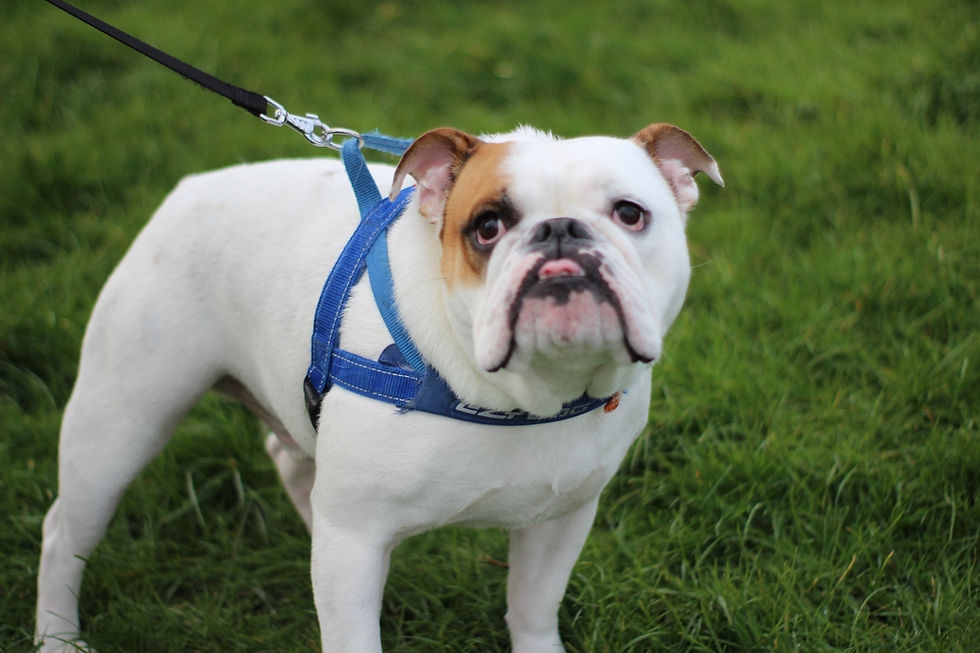Top Misconceptions about the Teenager Phase!
- Chelsea Murray CPDT-KA, KPA-CTP, CTDI

- Apr 27, 2023
- 8 min read

Often times bringing home a new puppy brings about a lot of joy. Snuggling, watching them enjoying the world for the first time, and setting training plans with great anticipation about what the future might hold. But what many don't know about dogs is that being a teenager is much harder than being a puppy- and surviving the teenager phase can sometimes feel impossible. Tackling the teenager phase comes with many challenges, which you can read about in our blog post here. But having the right frame of mind, realistic expectations, and a gameplan is essential. Today I want to break down some common misconceptions about teenagers and help you reframe your mind and your training routine for less stress and more success through this phase!
A tired dog is a good dog. Just exercise the crazy out.

During this age range of 6-18 months it is very common to see an increase in energy demands from our dogs. Teenagers can sometimes be described as "wild", "rambunctous", or even "crazy". This is because they have a ton of energy, so we can just head out for a jog or to play fetch to let them run the crazy out, right? While all dogs need exercise and it is no secret that teens need more than our juvenile puppies, the answer is not to just run it out of them. Our teenagers are still growing and too much of the wrong kinds of exercise can even be dangerous for them (learn more here). Plus, remember that whatever your dog is rehearsing gets more normalized- and we do not want high arousal behaviors to become the norm. So instead, think slow and steady. Activities like long line walks, shorter hikes or nature walks with sniffing breaks, and even some at home canine fitness or parkour are great ways to blow off some of that energy. And while we often thing of physical exercise- mental activity like training and enrichment is essential. You can work on some training skills like settle on a mat to help them learn how to relax on cue and impulse control training to help them learn how to make good choices even when they may be excited. Adding more opportunities for enrichment with shredding of amazon boxes, more chews like bully sticks, and even training for meal times is a great way to provide outlets for them, which means "better" behavior indoors with you! Crates and gates are for puppies. For many of our clients the idea of having to live with your house covered in baby gates, crates, and x-pens is stressful. And often times with our puppies, we reach a point where they are fairly reliable with chewing and potty habits so we allow a little more freedom and begin to ease up on management. Unfortunately, the teenager phase should be full force management! Seriously, don't put them away! Our teenagers are easily excitable and opportunistic, they are growing and will soon be able to reach counters and get into trash cans, and they are still developing the part of the brain in charge of complex decision making. This is a recipe for trouble! Management helps set our dogs up for success by reducing or preventing the liklihood of our dog rehearsing undesired behaviors like a closed door preventing a dog from accessing an open bathroom trash can, a baby gate to block the kitchen to avoid counter surfing, or a baby gate around your front door to prevent jumping on guests or running out! This management is used in addition to reinforcement from us to show them what we do want!
Humping and mouthing are signs of dominance.

Teenagers are easily excitable and sometimes this can tip over the top and we can see a dog who is lacking the ability to control those emotions. Sometimes we see this as jumping and mouthing during play, or even humping and biting the leash while you walk. While this is undesirable to see and experience, its not abnormal so don't panic. Your dog is not feeling sexual and they are not trying to assert their dominance over you.
Our teenagers can easily become stressed, frustrated, and even over excited. While some of this behavior will improve with age- there are things we can do that can make it worse or better. In the moment, try to remain calm. Becoming agitated, moving around, pushing the dog off you or even yelling can all make this behavior worse like adding fuel to a fire. Remaining calm can help your dog calm back down. You can offer something like a treat scatter to help get the dog off you and redirect them back to the floor. Then once your dog is focused on the treats and finishes eating them you can start to ask your dog for simple and well-known behaviors or simply capture already offered behaviors of calmness like sit or down.
We also can help increase our toolbox in training sessions to help our dog learn to calm down. Working on teaching our dogs to take a breath is a fabulous way to help them calm down. Deep breathing for dogs, just like people can lower arousal and excitement and can help them refocus after an event. In addition to working on relaxation, I like to challenge our teenagers by jazzing them up and then asking for and rewarding relaxation. This helps recreate these high-intensity moments in a structured session and helps them learn how rewarding relaxation is- making it easier for them to do it down the road when they may become overstimulated again. We can work on a similar concept both on and off lead with play! These activities can help our dog's begin to learn how to control that excitement.
And it is always important to observe patterns. Often times dog owners notice that they always see this behavior in specific circumstances like having to walk past another dog while on a walk or while they are playing fetch. Knowing more details about when this behavior is occurring can help you as an owner get ahead of the behavior. See a dog coming towards you on a walk? Offer a treat scatter or magnet hand to help them move in another direction completely avoiding this stimulating moment. Does your dog latch on to you while in the middle of a fetch game? Break up short sessions of fetch with a nice sit or hand target for a treat to let them take a breath. Or, temporarily stop fetch and look for other more calming outlets for them.
My puppy is so good off leash- we've done it!

Have you ever noticed how your puppy follows you around, even off leash? Many people love to show off their doting puppy walking around their front yard with them. Unfortunately true off leash reliability takes months, if not years to master. Many times this velcro puppy who wouldn't dare leave your side one day leaps at the first distraction to chase down the road! "AGH!", what happened? Your puppy became a teenager and now has a lot of interest in the outside world!
As tempting as it may be to allow your pup to roam off-leash, this can quickly lead to a bad habit of running away, can poison your recall cue as you desperately plead for them to come back, and can even result in your dog getting into a dangerous situation with other dogs, people, or cars. But all of this can be avoided by introducing your pup to long lines when you are not in a fenced area! Long lines have so many benefits to them and if you are interested in gaining off-leash reliability for future adventures, long lines are a great training tool to help you begin to build that focus and recall!
He's not food motivated.

Training a teenager can be a true test of our patience. But what if said teenager doesn't want our food? Are they stubborn or just not treat motivated? The great news is neither! Intact dogs are experiencing a lot of hormonal changes during this developmental stage of their life- and sometimes this can decrease their interest in food. Also, as excitability in the world around them increases or as the environment becomes more scary in a fear period, desire and ability to eat changes. If we see our dog turn their head to our treats, we need to take a step back and evaluate what is going on. A few questions you can ask yourself:
1) Did I make it too hard too fast? These distractions might be too close to us tor too challenging for my dog's skill level right now. 2) Is my treat motivating for the dog? Its possible this environment or the difficulty of this behavior I am asking for requires a bigger paycheck! Kibble may work for inside training and reinforcement throughout the day, but outside recall may need the big guns like chicken or cheese! 3) Have my dog's basic needs been met? Temperatures that are too hot or too cold, or even the need to go potty can impact training. Have you ever tried to do calculus when you had a full bladder? 4) Are you feeling ok? Do you notice other symptoms? Not wanting to eat normal meals, drooling, lethargy, vomiting, and diarrhea are just a few signs that your dog might have something else going on and a trip to the vet might be needed. 4) Where CAN my dog eat? Go back there! This will help you immediately find a place where your dog can be successful. This can often give you some time as well to evaluate what could be going on. Teenagers are HARD, but its just a phase! It is true that living with a teenager will test your training creativity and your patience. You may return to sleepless nights, see regression in housetraining, or even throw your hands up wondering why your dog no longer knows how to "sit" on cue. But it is a dangerous game saying it is just a phase. While many of these big challenges for our dogs, and us, stem from developmental changes associated with this age range, behaviors that are rehearsed will happen again. Why does this mater? Becoming lax on training or allowing our dog to "be naughty" during this time can quickly set our dogs up for failure in the future as they may learn that all of these behaviors are okay to rehearse. And trust me, as we try to "get rid of bad habits" going through extinctions bursts are not fun. It really does get much worse while we work on making it better. Helping our dogs learn right from wrong doesn't mean we have to correct the dogs to show them behavior are wrong- but it does mean we may have to change the environment to reduce the likelihood they can rehearse undesired behaviors, it means we may have to take a step back in our training plans to cover the foundations again, and it means lots of patience and tools as we redirect and reward them. This is still our strong foundation for their bright future- this time is important! If you are patient and consistent with them- you both will get on the other side of this phase with success. Questions about your teenagers? Who doesn't have them! Don't hesitate to reach out to us! Our team can easily assist you with your teen in-person or virtually to help you evaluate your training plans, rework management, and get you back on track with your sanity!




























Comments